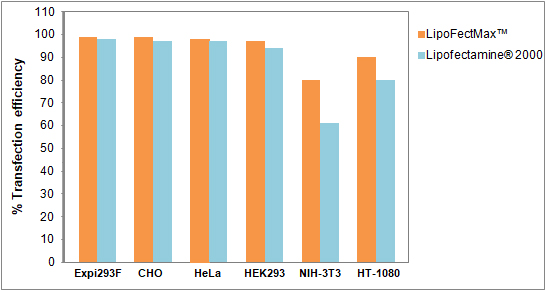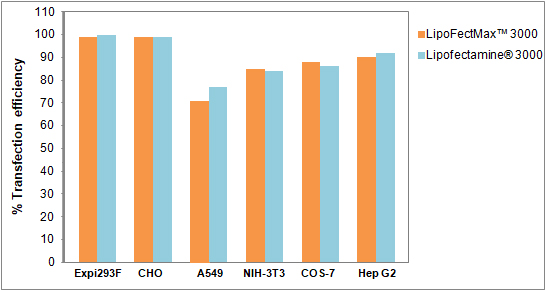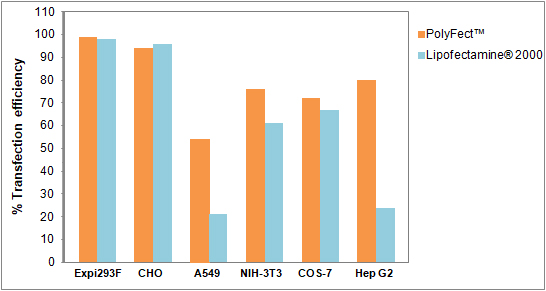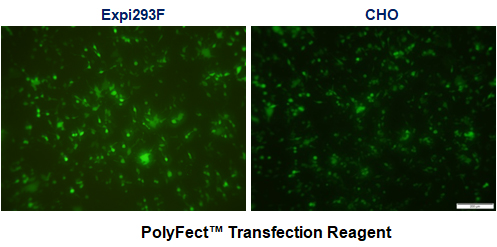Transfection is the process by which nucleic acids are introduced into mammalian cells. When selecting a transfection reagent, consider the type of nucleic acids (DNA, or RNA) you wish to deliver and the type of cells you want to transfect.
Transfection Reagent Selection Guide
| Cat No. | Product Name | Application | Cell Type | Replacement for |
| FP310 | LipoFectMax™ Transfection Reagent | DNA, RNA transfection | A variety of eukaryotic cells | Lipofectamine™ 2000 |
| FP318 | LipoFectMax™ 3000 Transfection Reagent | DNA, RNA transfection | The widest selection of hard-to-transfect and common cells | Lipofectamine™ 3000 |
| FP330 | PolyFect™ Transfection Reagent | DNA transfection | A variety of eukaryotic cells | PolyJet™ |
| FP332 | PolyFectRNA™ Transfection Reagent | siRNA or miRNA transfection | A variety of eukaryotic cells | Lipofectamine™ RNAiMAX |
| FP315 | Fect293™ Transfection Reagent | Protein expression | Suspension 293 cells | ExpiFectamine™ 293 |
| FP316 | FectCHO™ Transfection Reagent | Protein expression | Suspension CHO cells | ExpiFectamine™ CHO |
| FP317 | PolyFectVIR™ Transfection Reagent | Virus production | HEK-293 cells | FectoVIR®-AAV, PEIpro® |
Cationic Lipid based Transfection Reagent
ABP Biosciences developed novel cationic lipid based transfection reagents used for DNA/siRNA transfection. LipoFectMax™ Transfection Reagent has good transfection efficiency for most eukaryotic cells (attached or suspended). LipoFectMax™ 3000 Transfection Reagent has higher transfection efficiency for some difficult-to-transfect cells, primary cells, and neuronal cells.


Figure 1. Comparison of LipoFectMax™ and LipoFectMax™ 3000 with Lipofectamine® 2000 and Lipofectamine® 3000 transfection efficiencies. Expi293F, CHO, A549, NIH-3T3, COS-7, HepG2 cells were transfected with a GFP-expressing plasmid using LipoFectMax™, LipoFectMax™ 3000, Lipofectamine® 2000 and Lipofectamine® 3000 transfection reagent, respectively. Cells were evaluated for transfection efficiencies after 48 hours post-transfection.

Figure 2. The transfection efficiencies of LipoFectMax™ and LipoFectMax™ 3000 in Expi293F, and CHO suspension cells both are over 95%, ideal for protein expression.
Biodegradable Cationic Polymer based Transfection Reagent
ABP Biosciences developed a novel biodegradable cationic polymer based transfection reagents used for DNA transfection. PolyFect™ Transfection Reagent is suitable for a variety of adherent and suspension cell lines.

Figure 3. Comparison of PolyFect™ and Lipofectamine® 2000 transfection efficiencies. Expi293F, CHO, A549, NIH-3T3, COS-7, HepG2 cells were transfected with a GFP-expressing plasmid using either PolyFect™ transfection reagent (yellow), or Lipofectamine® 2000 (blue). Cells were evaluated for transfection efficiencies after 48 hours post-transfection.

Figure 4. The transfection efficiencies of PolyFect™ in Expi293F, and CHO suspension cells are over 95%, ideal for protein expression.
Related Products
- Nucleic Acid Gel Stains
- Nucleic Acid Quantitation
- Labeled Nucleotides
- Protein Detection and Quantitation
- Cell Structure Probes
- Secondary Antibody and Streptavidin
- Cell Proliferation & Viability Assay
- Cell Apoptosis Assay
- Andy Fluor™ Dyes
- Ion Indicators
- Transfection Reagent
- Luciferase Assay Kit
- ECL Western Blot Reagent

